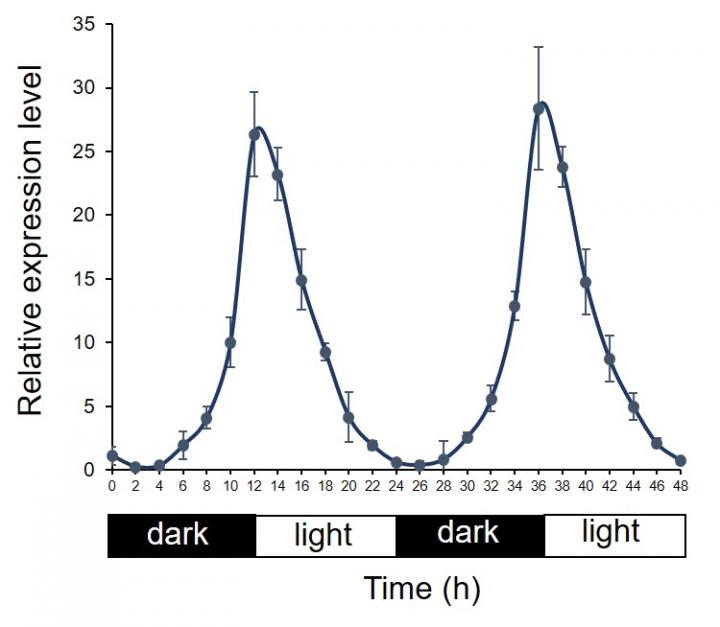
IMAGE: The leaf blade of rice seedlings was sampled every 2 hours for 2 days. Expression of the OsMGT3 gene relative to 0 hours is shown.
view more
Credit: 2020 Nature Plants
The fundamental process that arguably forms the backbone of life on earth is photosynthesis; every organism is directly or indirectly dependent on this process. On paper, the process is simple: plants (and other organisms that have “chloroplasts,” the structures where photosynthesis takes place, and give the characteristic green color to leaves) convert solar energy into chemical energy that helps them grow and flourish, and other “higher” organisms depend on these plants, or on organisms that feed on these plants, for their own sustenance, and so on.
But in practice, and especially at this point in biological history, this process is not so straightforward. The human population is growing at an unprecedented rate; the resources we have are not enough to feed the billions of people on earth today. While policymakers and politicians are trying to optimize the use of existing resources, scientists are doing their bit by figuring out how to improve the resources by exploring whether the natural process of photosynthesis can be modified through the latest technologies to ultimately improve the yield of food crops.
A team of scientists led by Prof Jian Feng Ma from Okayama University, Japan, and Prof Zhichang Chen from Fujian A & F University, China, also set out to explore photosynthesis, but they decided to do this with a twist: while current research predominantly focuses on trying to modify the direct chemical reactions involved in photosynthesis, the team decided to look at the “diel” variations–or the variations that occur over a periodic cycle of 24 hours–in photosynthesis.
That many processes of photosynthesis exhibit 24-hour variations shouldn’t come as a surprise, given that the entire process is dependent on sunlight. Apart from external light-dark conditions, these diel changes can also be driven by internal genetic mechanisms.
But what exactly did these scientists look at? “Our study focused on magnesium, and for a diverse set of reasons,” explains Prof Ma. “Magnesium is an essential macronutrient for plants, but around 15-35% of total magnesium intake is allocated to chloroplasts, where it functions not only as a structural element of chlorophyll but also as an activator for a number of photosynthetic enzymes.” This meant that studying the diel changes in magnesium can shed light on an important functional aspect, and potential target for manipulation, of photosynthesis.
Through gene studies in the rice plant (the results of which are published in Nature Plants), the researchers decided to narrow in on a magnesium ion transporter OsMGT3, found in chloroplasts, and are known to be rhythmically expressed in “mesophyll” cells, the cells specialized for photosynthesis.
They created genetically modified rice plants in which the gene that gives rise to OsMGT3 was absent; they found that these plants showed significantly reduced uptake of magnesium and reduced amplitude of free magnesium ion fluctuations in chloroplasts. This resulted in a decrease in the activity of “ribulose 1,5-bisphosphate carboxylase,” a fundamental enzyme of photosynthesis, naturally leading to a decline in the photosynthetic rate. Next, through genetic engineering techniques, they caused the excessive production of OsMGT3 in mesophyll cells in normal rice plants and found that the photosynthetic efficiency and growth improved in these plants.
These experiments proved that OsMGT3 partially controls the magnesium fluctuations in chloroplasts, and that these fluctuations may contribute to magnesium-dependent enzyme activities for photosynthesis over the daily cycle.
So where does this leave us in terms of optimizing crop yield and feeding the masses? Prof Ma states that the findings open up hitherto unexplored avenues, remarking, “Our studies put magnesium in the limelight. Modifying the magnesium input into chloroplasts could be a potential approach to improving photosynthetic efficiency in plants and can eventually improve crop yield.”
This study, along with future studies that would demonstrate how exactly magnesium should be targeted, could be a potential answer to the global food shortage.
###
TDnews














